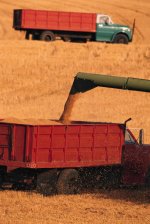

To send a message to an author, click on the author's name at the end of the article.
This Month in Ag Connection | Ag Connection - Other Issues Online
Agriculture has a set of financial ratios that have been used for many years by lenders and farmers. That set of ratios, often called "The Sweet 16" was developed many years ago by the Farm Financial Standards Task Force after the farm crisis of the 1980's.

The Sweet 16 includes several common ratios such as the current ratio, debt to asset ratio and net farm income ratio. The ratios are simply a yardstick to see how a farm is doing over time (is it becoming more profitable) or to compare it to similar farms.
The ratios are categorized into five categories: 1) liquidity (ability to meet obligations as they become due), 2) solvency (ability to pay all debts), 3) profitability (difference between value and cost of goods produced), 4) repayment capacity (ability to pay term debts on time) and 5) financial efficiency (how effectively assets are being used to generate income).
These ratios have worked fairly well for many years, but occasionally the need for additional information arises, so the task force this year added five additional ratios, for a total of 21 ratios. The five new ratios are:
The ag business specialists have a scorecard (available in the online version of Ag Connection) available that shows whether your numbers are strong or if they are in the vulnerable category. They also have more information about where to find the numbers to use in the calculations. For more information contact MU Extension Ag Business Specialists: Mary Sobba 573-581-3231 or Parman Green 660-542-1792
Source: Mary Sobba, MU Extension Ag Business Specialist)
This Month in Ag Connection | Ag Connection - Other Issues Online

It is a delicate task to balance drying grain and minimizing the energy required for drying. One should consider letting crops dry in the field as much as possible. In general, in Missouri, one should try to average about 22 to 23% moisture during the harvest season to minimize field losses and minimize drying costs. This means trying to start harvesting at about 28% moisture. These figures were developed by Bob George and Ed Constein, State Agricultural Engineers in the 1970's, but they still apply today.
One of the most efficient drying methods is to use natural air for drying. While it takes more management, natural air can be used to dry grain that is below 30 percent moisture. When using natural air, it is important to match fan capacity to grain bin volume and do not over-fill bins. MU Guide 1310, Low-Temperature In-Bin Drying: Shelled Corn in Southwest, Central and Northern Missouri. This is available at: http://extension.missouri.edu/publications/DisplayPub.aspx?P=G1310 This guide uses typical weather conditions for Missouri to determine the depths of grain that can be dried. It also gives the sizes of fans needed to dry and adjusts grain depths for fans that don't match those sizes. Very seldom do we have a typical year so one should check the grain regularly for any problems that might occur.
Grain depth at various moisture levels can be determined from this guide. Once the grain is dried, more grain can be added. The depth of grain to be added should be determined by the moisture level of the grain to be added. Using multiple grain bins, you can dry a large volume of grain with natural air.
Stirring devices can be installed in bins to increase the drying capacity. Care should be taken to install and operate them correctly. The airflow in bins is increased, thereby increasing the drying capacity. If used properly, over-drying can be minimized by the mixing of the grain.
Inspect and maintain grain bins and equipment:
Management during harvest and drying:
Grain moisture during harvest and drying should be checked regularly. Be sure you don't over-dry the grain. If you have automatic controls, check them regularly. Once you start drying in the bin, keep the fans running continuously regardless of the weather until the entire mass of grain in the bin is dried. However, if natural air drying and humidity is high, such as raining for a week, shut fans off and resume when air dries out. Dry the grain to the following moisture levels:
| Store over winter/6 months | Store more than 6 months | |
|---|---|---|
| Corn | 15 | 13 |
| Soybean | 13 | 11 |
| Grain Sorghum | 15 | 13 |
| Wheat | 13 | 11 |
Management of grain during storage:
After grain is dried, it should be cooled in the fall to about 40 degrees. This will avoid moisture migration in the bin due to temperature differences between the grain in the bin and the outside air temperatures. Check the grain regularly throughout the winter by running the fans to check for musty odors. Take the temperature of the grain and record it to observe any changes in the temperature. Grain should be warmed in the spring by turning on the fans and blowing warm air through the grain. When the grain is cooled or warmed, care should be taken to be sure the cooling or warming front moves completely through the grain.
Long-term considerations:
If you feed your grain to livestock, consider high moisture storage of the grain.
Source: Don Day, MU Extension Associate Energy
This Month in Ag Connection | Ag Connection - Other Issues Online

Researchers at the University of Missouri compared three typical methods of wintering beef cows. However, nobody has actually done the research, until now, to see if there truly is a difference in cow and calf performance between these "typical wintering methods." The three methods included in this study compared, feeding only hay (HY), feeding hay with a supplement (HS) or feeding stockpiled tall fescue (STF) over a two-year period, during the winters of 2006 and 2007.
The hay in the HY and HS treatments was very typical of Missouri fescue hay; the crude protein (CP) and neutral detergent fiber (NDF) were 7.7 %, 71.6% and 8.0%, 74.2% for year 1 and year 2, respectively. Needless to say, the hay was definitely on the low end of the quality scale, but is very typical in Missouri.
During August of both trial years, 40 lbs N/acre from ammonium nitrate was applied to the STF paddock treatment and allowed to grow until the start of the trials in November 2006 and December 2007. The STF treatment had pre-grazing nutrition levels of 11.8 % CP, 67.2 %NDF, and 36.2 % ADF, which was definitely higher in nutrition than the hay. STF was strip-grazed and the cattle were moved approximately twice a week. At the end of the winter grazing season the STF had decreased CP 7.4%, and increased ADF and NDF levels (the higher the ADF and NDF values, the lower quality the forage is), and still better nutritionally than the hay.
During year 1 of the trial, HS treatment cows were supplemented with 0.88 pounds of corn per day until midway through the calving season (March 16th) and then increased to 2.7 pounds of corn plus 3.2 pounds of dried distiller's grains with solubles (DDGS) per day until March 27, 2006 (the end of year number 1). During year 2, cows in the HS treatment were supplemented with 2.4 pounds of corn and 2 pounds of DDGS for a total of 4.4 pounds per day of supplement, throughout the winter period, which ended March 26, 2007.
Basically, the results of the three treatments showed what producers could expect to see at home. The STF cows actually gained almost 50 pounds during the first winter while the cows on the HY and HS treatments lost 12 and 39 pounds, respectively. During year 2, cows on STF, HS and HY lost 114, 109 and 187 pounds respectively. One reason for the dramatic weight loss, in year 2, was the cold wet weather increasing their energy requirements. Snow and ice also decreased the accessibility of the STF, which could explain the average weight loss of 114 pounds.

When all was said and done, the STF and HS cows made it through the winter better than the HY cows. The HS cows seemed to regain their weight losses with spring grass. It is interesting to note in year 2 that the HS and HY cows had a higher incidence of calf death due to hypothermia and respiratory diseases. The researchers observed that the STF treatment didn't have the mud problems that the other two treatments had. Cows and calves were constantly being moved in the STF treatment, which deceased the time they spent in wet and muddy areas.
After seeing the results of this particular research project, stockpiling fescue makes practical sense. Take advantage of the ample rain we have had this past year, add some nitrogen fertilizer to a hay meadow or pasture and invest in some temporary electric fence and you will not only have a great source of nutritional winter feed for your cows. The beef cattle market is in somewhat of a downturn this year, so make every penny count and wean as many live healthy calves as you can. This research project shows that producers can keep more live healthy calves when stockpiling, and that cows will winter better with that "old fescue" when it is fed right. Cows and calves will be more comfortable and do better over the course of the winter.
Source: Wendy Flatt, MU Extension Livestock Specialist)
This Month in Ag Connection | Ag Connection - Other Issues Online

The Central Missouri Region agriculture staff would like to say thank you to Dee Cooper for her role in supporting the agriculture producers our region. Dee has been a part-time livestock specialist in the Callaway county office. She was assisting Mark Stewart while he has a special assignment. She has assisted with a safety program for the Amish, programs for extending winter hay supplies, consultations with producers and was on the editorial board of Ag Connection. Her last day with MU Extension was August 19, 2009.
Author: Joni Ross, MU Extension Agronomy Specialist
This Month in Ag Connection | Ag Connection - Other Issues Online
Over the years financial planners have encouraged the use of 529 plans (higher education saving plans) as a saving vehicle for the cost of higher education. MOST - Missouri's 529 college savings plan warrants your consideration. So why are we hawking 529 plans? Earnings and funds taken from 529 plans to pay the costs of higher education avoid income taxes, even the kiddie tax. The kiddie tax is the tax provision that can tax the unearned income of dependent children at the highest marginal rate of the parents, rather than the child's lower marginal rate.
Originally, when the kiddie tax was implemented in 1987, it was targeted for dependents under the age of 14. In 2006 the applicable age was changed to those under age 18. Even then, the kiddie tax didn't impact many children in college. However starting in 2008, the kiddie tax is expanded to apply to dependents who are full-time students under the age of 24. Again, the extra tax bite is only on the unearned income (interest, dividends, and capital gains) of the child. But for many full-time students - they have more unearned income than earned income.
Key planning pointers:
For information on Missouri's MOST 529 plan go to https://missourimost.s.upromise.com/
Source: Parman R. Green, MU Extension Ag Business Mgmt. Specialist
This Month in Ag Connection | Ag Connection - Other Issues Online
Publishing Information
Ag Connection is published monthly for Northeast and Central areas of Missouri producers and is supported by the University of Missouri Extension, the Missouri Agricultural Experiment Station, and the MU College of Agriculture, Food and Natural Resources. Managing Editor: Mary Sobba.